A traveler and a writer, Gangadharan Menon,
mentioned about bishnoi community and their sacrifice in his book ‘Evergreen
leaves’, which among many other stories in the book lost a track in my mind. But
it seems I was destined for Bishnoism. In Aug’15, I met a pride Bishnoi named
Bhavya during my expedition in Ladakh. We all were giving our life stories at 14000 ft in our camp near the Pangong lake. I was done with mine and it was Bhavya's turn now. When he was narrating about his
story he told about his community and about Bishnoism. I said to myself ‘hey, I know about this’.
My memories became alive again and few months later when I was planning to
visit Rajasthan to attend a friend’s marriage, I made it a point to myself, I
will be visiting a Bishnoi Village for sure and I wanted to go there alone.
It's time I mention about the sacrifice. Bishnois consider the tree of Khejari as very sacred. Jambeshwar ji alongside the 29 principles mentioned about this tree as a symbol of prosperity. Like most bishnoi villages, Khejarli had this tree in abundance as the villagers never cut it. Infact they plant them at every auspicious occasion. In 1730, the then ruler of Jodhpur, Abhay singh, needed wood for his palace. Considering the Bishnoi village had lot of greenery unlike any other place in Thar, the king asked his men to get the wood from the village. Following the orders the men arrived at village but got resistance from the villagers to cut their holy tree, mainly lead by Amrita devi Bishnoi. The villagers hugged the trees to save them from cutting. The king's men warned that they will cut their heads to get the wood. "Sar santey rukh rahe to bhi sasto jaan" Amrita devi said (if a tree is saved even at the cost of one's head, its worth it). She and her daughters were killed and 360 others, before the news reached the king and he ordered to stop the massacre.
I saw a small tea shop here owned by this another friendly person, really particular about the cleanliness around it. He gave me details about Guda Bishnoi and that tomorrow the first bus to Jodhpur leaves at 10.30am. As he suggested, after having the tea I started walking down the road to Guda Bishnoi asking for a lift to every vehicle that crossed me. Finally a school bus stopped and I got a lift till village. The driver told me about the lakes and also as I had just a 110Rs in my pocket (my bad) I asked about the nearest ATM which was 8Kms away. He pointed me towards the route to lake and dropped me. Right after I was surrounded by these numerous kids all asking for ball pens and chocolates.
I asked them to take me to the nearest shop
from I can get and give them. The shopkeeper saw me surrounded by these naughty
kids and came for rescue. He told how these kids harass all foreign travelers.
I need not to get anything for them. Soon the disheartened kids went away, but
still a few wanted to join me for the lake. I asked them that I will go alone,
so they went away as well.
While I walked alone, I was joined by this very polite kid called Pawan Hans Bishnoi who was going towards his home carrying a football in his hand. I taught him few tricks to dribble, whatever I knew and asked him if I can visit his house to meet his family (I was curious to meet a Bishnoi family). He agreed and also helped me to check out a lake on the way. Couldn’t spot any deers but I did see a Nilgai and a wild boar.
Later we went to where saw his father sitting in sun. I introduced myself and asked him about the Bishnoi life and the tree of Khejari. He explained me about the medicinal values of the Khejari fruit and also how healthy Khejari trees signifies prosperity of the place. I also got introduced to his mother, few other elderly women of the house and Pawan's cousins.
I had a tablet computer with me on which I showed them few documentaries, though they were more interested to watch some Bollywood movie which I didn’t had.
It was around 4pm now and I wanted to reach Khejarli before it gets dark. After a cup of tea served to me, this young army of 4, Aman, Jitesh, Pavan and Mahendra, they accompanied me to the second lake where there are higher chances of spotting deers. We kept walking for about 15-20 mins during which I had a nice chat with these kids, spotted few unknown birds and a group of Nilgai (3 of them).
We then entered the shrub area following the Nilgai herd
and finally one of the kid yelled, there they are. There were two of the
chinkara deers. Unlike the common spotted deers, chinkara’s are more adapted to
arid landscapes surviving on mainly the berries of the shrubs that were in
plenty here. These deers are really quick and shy. Moment I saw them they were
running to safety. Mahendra suggested me the path to follow if I want to see
them again but I was already happy.
We started walking back and our talk continued. It was interesting to know that wheat or rice does not grow in Thar but is brought from other places. Only bajra, dal, moth and other cereals suitable for this land grow here. The kids recited all that grows here and also climbed a tree nearby to get me berries. I got plenty of them and they were really tasty.
Then they followed me to the main road which was around 2Kms away. On the way I met few curious villagers who wanted to know from where did I come. I avoided them mostly as the kids narrated about a family who steal stuff from the Jodhpur city.
Day 2 - 10Dec 2015
I woke up just in time to rush for bath and get ready. All were already at the temple except Himmat singh ji who was putting his efforts to lock the door. I guided him his way till the temple holding his wooden stick. While I talked with him I felt a dissatisfaction of life in him. He continuously talked about how difficult is a life for a blind but a comparison he always drew with Surdas, the famous hindi poet. I felt helpless and asked him if he consulted any doctor. He told his blindness could have been cured in childhood but his parents didn’t have money and now it cannot be cured. I just gave my words to him to accept his life like that and consider this a god’s decision.
A day before I left for Rajasthan, I got in touch with my
old Bishnoi friend from college (till now I ignored that he was a bishnoi and only saw him like just
any other friend). He is Surender Bishnoi, now a colleague as well in
Microsoft. He told me about Mukam, where Jambeshwar ji the founder of bishnoism gave the 29 principles,
and about Khejarli where the historical sacrifice happened. Both are pilgrimage
places for the Bishnoi community now but I was more interested in Khejarli. 2
months earlier I blindly booked train tickets for my 2 days solo travel around
Jodhpur, just aware of the fact the Bishnoi villages are near Jodhpur. But as
me and Surender checked on google, we realized Khejarli is 180Kms from Jodhpur.
Surender had never visited this village so he was not aware of how to reach and
what stay options exist. I just left for Rajasthan without much planning, only
relying on asking the locals once I reach Jodhpur.
It was early morning 6am on 8th Dec when I
boarded the train. I did not sleep entire night due to the marriage ceremonies,
so I was unconscious the moment I reclined on my seat. The 4.5 hour journey
seemed finished in no time as I got down of the train. With very less hopes to
visit Khejarli, I just roamed around the station to try some local breakfast
and also get some info if I could make it as I had another train to catch at
8PM next day. I found a decent sweet shop where I tried the local onion
kachori. At this shop I bumped into Mohan Bishnoi ji, who works at this shop as
salesman. As I inquired, he was discussing with his friend in Marwadi and I caught their
context when he mentioned “Shaheedi Smarak” (Sacrifice memorial). I just
intervened into their conversation “yes right, I want to go to that same
village”. Mohan ji mentioned there are direct buses from here. That made me
really happy and then was the breaking news when I asked ‘How far it is?’ He
said 25Kms! That’s it! After that I lived the most wonderful day of my life!
Mohan ji told me about Shankar das ji, the head priest of
temple who can help me with food and stay. He then helped me get an auto to the
bus stop from where I could get bus till Khejarli. At this small bus stop I met
the really friendly driver and conductor who were happily sipping their tea. I
also joined them and had a small talk alongside a tea. We boarded and started
around 12 for the village. I was observing the dresses of the men and women
around me who boarded the bus. I saw all these either in books, or on stage shows. They seemed coming right out of a story book. It was interesting
to see them wearing special turbans and jewelry as part of their regular lives.
On my seat sat an elderly Bishnoi, Ramkishan ji going
towards kakelao village on way to Khejarli. I started a conversation with him
but as he asked my caste and religion I found it really odd and refrained from
talking further. But then I calmed myself considering this as a way people in
small places interact, and continued my talk. He shared me a lot of information
about Khejarli and villages around. He told me about another place, Sajada
dham where I can find food and stay, if not the temple. As I was really
interested to see deers, he suggested me about guda bishnoi village
where there are two lakes around which deers can be found, even blackbucks. Bishnois live alongside wildlife. So and so, bishnoi women even feed the small deers their own milk treating them as own children.
Before getting down of the bus, Ramkishan ji offered a
stay in his house if I do not find it anywhere saying "we will also get a
chance to help a devotee". I was overwhelmed with that gesture and the kind heart of this villager.
I got down near the temple road as Ramkishan ji guided me. I was a completely
different feeling as there was not even a single soul around at this deserted
road.
I then reached the gate of the temple from where I could see a small room
at a distance, the pathway leading to it surrounded by trees.
The walk was very
peaceful as I was alone, truly in the lap of nature walking slowly towards the
temple hearing the numerous calls of birds around me. I saw peacocks, this
different babbler species, the grey francolins, a woodpecker and a lot of
squirrels. I found a bench near the memorial that was erected here to commemorate
the sacrifice of the 363 people who sacrificed their lives to save their trees.
It's time I mention about the sacrifice. Bishnois consider the tree of Khejari as very sacred. Jambeshwar ji alongside the 29 principles mentioned about this tree as a symbol of prosperity. Like most bishnoi villages, Khejarli had this tree in abundance as the villagers never cut it. Infact they plant them at every auspicious occasion. In 1730, the then ruler of Jodhpur, Abhay singh, needed wood for his palace. Considering the Bishnoi village had lot of greenery unlike any other place in Thar, the king asked his men to get the wood from the village. Following the orders the men arrived at village but got resistance from the villagers to cut their holy tree, mainly lead by Amrita devi Bishnoi. The villagers hugged the trees to save them from cutting. The king's men warned that they will cut their heads to get the wood. "Sar santey rukh rahe to bhi sasto jaan" Amrita devi said (if a tree is saved even at the cost of one's head, its worth it). She and her daughters were killed and 360 others, before the news reached the king and he ordered to stop the massacre.
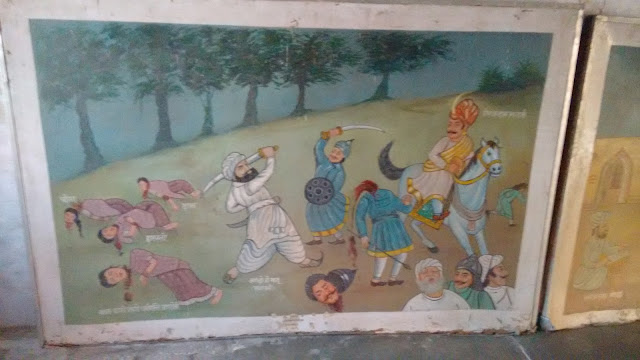 |
| a painting inside the temple depicting the massacre |
A board near the memorial explained the complete story of the massacre. I closed my eyes and sat here for some time to meditate and enjoy the silence I
was getting from this place and remembering the people who died here.
Later I went to search around for Shankar das ji. I saw from
a distance someone lying on a charpai outside a room with a SUV parked
as well. There was another guy checking his phone sitting near his feat. This
guy was 18yr old Sravan Bishnoi, a disciple of Shankar das ji. I said namaste
and asked about Shankar ji, he told me here is him. I told them I have come
all the way from Hyderabad to visit this temple and the village. They were
really happy to meet me and readily offered me a room when I asked if there is
a provision for stay available here.
Sravan showed me the room, a very basic shelter that you can
imagine but sufficient to sheild you in the cold night. There 7-8 beds that
stood vertically inside this small space. I pulled one of them down and put my
own blanket and bed sheet, thankfully I had those.
While I was getting ready for snaan (bath), Shankar Das ji came to the room and asked to have lunch after I freshen up. On way to the bathroom I saw him taking care of his cow which was due its delivery soon.
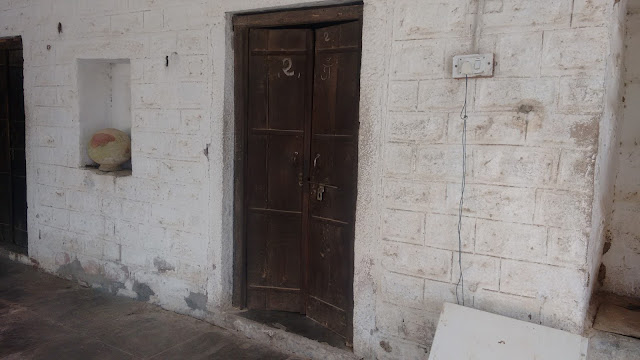 |
| the room.. :) |
While I was getting ready for snaan (bath), Shankar Das ji came to the room and asked to have lunch after I freshen up. On way to the bathroom I saw him taking care of his cow which was due its delivery soon.
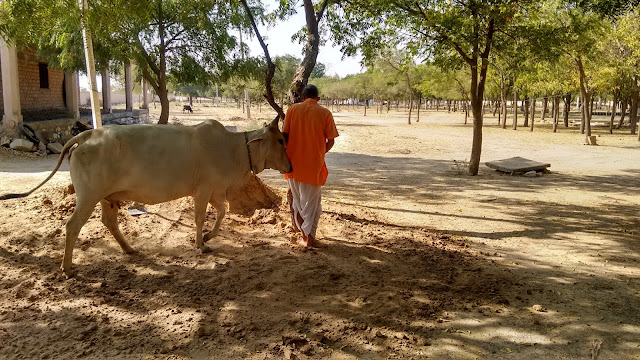 |
| Shankar das ji with his cow |
After the bath I went to kitchen along with Sravan. I sat on
the ground on a jute bag and Sravan served me a really tasty meal of simple dal
and roti, and the special cow ghee which Sravan poured on it. I was delighted
by the hospitality of them.
While having the lunch I talked with Sravan about the places around, especially where I can spot deers. He mentioned about Guda Bishnoi and Kakehan. Kakehan is also known for local pottery which I was curious to explore. I headed out for my days travel again walking down the deserted road outside the temple towards the Khejarli village.
 |
| Sravan ready to serve me food.. |
 |
| the amazing daal roti and ghee.. i miss that taste.. |
While having the lunch I talked with Sravan about the places around, especially where I can spot deers. He mentioned about Guda Bishnoi and Kakehan. Kakehan is also known for local pottery which I was curious to explore. I headed out for my days travel again walking down the deserted road outside the temple towards the Khejarli village.
I saw a small tea shop here owned by this another friendly person, really particular about the cleanliness around it. He gave me details about Guda Bishnoi and that tomorrow the first bus to Jodhpur leaves at 10.30am. As he suggested, after having the tea I started walking down the road to Guda Bishnoi asking for a lift to every vehicle that crossed me. Finally a school bus stopped and I got a lift till village. The driver told me about the lakes and also as I had just a 110Rs in my pocket (my bad) I asked about the nearest ATM which was 8Kms away. He pointed me towards the route to lake and dropped me. Right after I was surrounded by these numerous kids all asking for ball pens and chocolates.
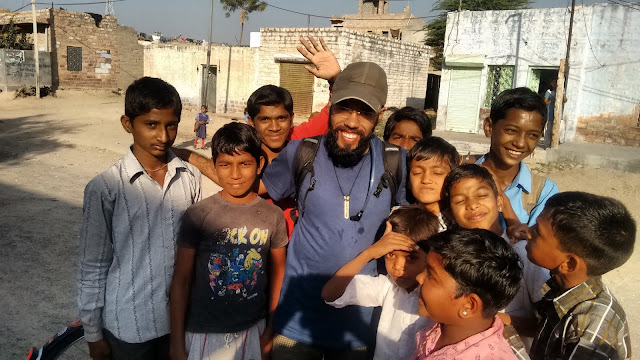 |
| the gang of kids |
 |
| the shopkeeper who helped me.. |
While I walked alone, I was joined by this very polite kid called Pawan Hans Bishnoi who was going towards his home carrying a football in his hand. I taught him few tricks to dribble, whatever I knew and asked him if I can visit his house to meet his family (I was curious to meet a Bishnoi family). He agreed and also helped me to check out a lake on the way. Couldn’t spot any deers but I did see a Nilgai and a wild boar.
Later we went to where saw his father sitting in sun. I introduced myself and asked him about the Bishnoi life and the tree of Khejari. He explained me about the medicinal values of the Khejari fruit and also how healthy Khejari trees signifies prosperity of the place. I also got introduced to his mother, few other elderly women of the house and Pawan's cousins.
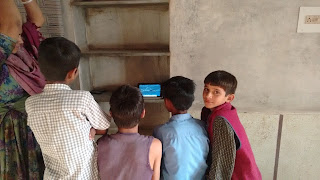 |
I had a tablet computer with me on which I showed them few documentaries, though they were more interested to watch some Bollywood movie which I didn’t had.
It was around 4pm now and I wanted to reach Khejarli before it gets dark. After a cup of tea served to me, this young army of 4, Aman, Jitesh, Pavan and Mahendra, they accompanied me to the second lake where there are higher chances of spotting deers. We kept walking for about 15-20 mins during which I had a nice chat with these kids, spotted few unknown birds and a group of Nilgai (3 of them).
 |
| team of kids.. Hitesh, Pawan, Aman and Mahendra.. posing near a young Khejari tree.. |
We started walking back and our talk continued. It was interesting to know that wheat or rice does not grow in Thar but is brought from other places. Only bajra, dal, moth and other cereals suitable for this land grow here. The kids recited all that grows here and also climbed a tree nearby to get me berries. I got plenty of them and they were really tasty.
Then they followed me to the main road which was around 2Kms away. On the way I met few curious villagers who wanted to know from where did I come. I avoided them mostly as the kids narrated about a family who steal stuff from the Jodhpur city.
We were finally on the road and it was almost dark now. The
kids showed a small lake nearby which was full of birds though I couldn’t
Identify any due to darkness. A bike rider gave me lift till Khejarli. On the
way he stopped at a liquor shop where 2 policemen did some basic questioning
about my whereabouts. I handled it fine and at Khejarli I met this young guy
who needed career guidance. He was doing BA for which I did not had much clue
but I suggested him to go into teaching. I was feeling a need of some
educational guidance institute here as I met many other school and college drop
outs.
Back to the temple I saw Sravan and others having their
meal. I saw 2 more people in kitchen, both junior priests. One of them is
Himmat Singh ji, who was deprived of vision since birth. I saw him at noon as well but couldn't talk with him. And the other priest was handicapped from leg. Since a normal life will be tough, if not
impossible, they opted to serve the temple for their life.
The priests take meals around 7pm and they thought I would
have had mine in the village as I was late. I was not hungry so I told them i’ll wait for some time. Sravan took me to his room to show Jambeshwar ji’s
photo and his granth that mentions the 29 principles. He told me about each
principle and also how the daily hawan pooja is carried out at the temple.
Tomorrow the pooja will be 7.30am onwards so I need to sleep early, to wake up
in time and take a bath before attending the hawan.
I saw Shankar Das ji moved his cow to the shelter inside as
it will be cold in the night. He served her a meal which he told me is bajra
diluted with water. The cow happily had it full. I then went for my dinner that
was yet again delicious with dal topped with onions served with bajra roti
topped with ghee.
After dinner I headed to my room without any delay to sleep
well before morning. I slid under the Jaipuri rajai that i got as a gift in Jaipur. I had an awesome sleep at this peaceful and blessed place.
 |
| even more tasty, bajra roti, daal, ghee, onion.. :P |
Day 2 - 10Dec 2015
I woke up just in time to rush for bath and get ready. All were already at the temple except Himmat singh ji who was putting his efforts to lock the door. I guided him his way till the temple holding his wooden stick. While I talked with him I felt a dissatisfaction of life in him. He continuously talked about how difficult is a life for a blind but a comparison he always drew with Surdas, the famous hindi poet. I felt helpless and asked him if he consulted any doctor. He told his blindness could have been cured in childhood but his parents didn’t have money and now it cannot be cured. I just gave my words to him to accept his life like that and consider this a god’s decision.
When we
reached the first tasks were carried out at the temple to set-up the hawan, the
loudspeaker and basic cleaning. Few elderly villagers also joined in. I took a
corner and the chanting started with continuous ghee feeding of fire that was
started by dry coconuts. The atmosphere was set and I gave up myself into it. I
just closed my eyes, my ears hearing to the chants and smell of the hawan
filling my lungs. I could even map few chants that Sravan told me the last evening.
Few other villagers also joined in, many women as well which signified the
importance of women in Bishnoi community.
The chants
ended with blowing of shankh and temple bells. It was quite a start of the day
for me.
With a smile on my face I started back again with Himmat singh ji. As he felt the warmth of sun he asked me stop for a while. We sat and talked more about his life struggle, mostly I was trying to ease him. I told him about learning braile after which he can read books. It was a tough conversation, especially when he discussed about colors which was hard for me to explain.
With a smile on my face I started back again with Himmat singh ji. As he felt the warmth of sun he asked me stop for a while. We sat and talked more about his life struggle, mostly I was trying to ease him. I told him about learning braile after which he can read books. It was a tough conversation, especially when he discussed about colors which was hard for me to explain.
 |
| Me and Himmat singh ji.. i remember he mentioned about his torn shoes.. |
I went back
to my room thinking to visit the village famous for pot making and then catch
the bus at 10.30. But I suddenly felt this silence which I am experiencing here
I may not get it again. So I lied on my bed and enjoyed a good 2hrs sleep.
I woke up after 11 and I knew I have missed the 10.30am bus. After
packing my stuff I went around the premise of the temple. I saw numerous Khejari trees planted there. I checked out the new
temple, very huge and is still under construction.
I then followed the calls of
these noisy birds only to realize that these were francolins sitting on a wall
making those noises. I sat near the memorial again for some time and then I
started back. I said my last byes to Sravan and Himmat singh ji. I met Shakar
Das ji earlier this morning when he was sitting in his car leaving for
Bikaner to attend some ceremonies. With very little money in my pocket I was
confused about offering anything to temple or Sravan, but no one asked for
anything.
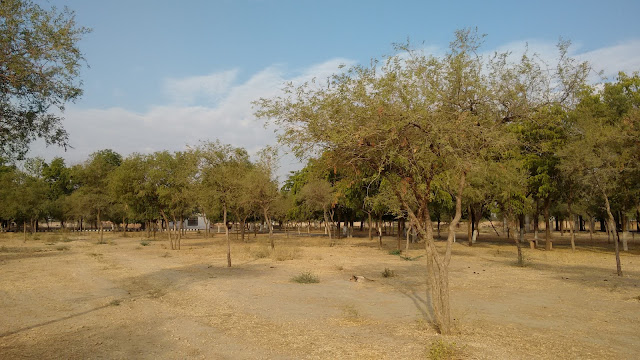 |
| they are all trees of Khejari |
 |
| the new temple, construction almost completed.. |
I reached
the tea shop again and came to know the next bus is at 2PM (2 hrs away) but the friendly owner
ensured me a ride to Jodhpur before that. Soon there was a TATA 407 on way to
Jodhpur that stopped for a second and he got me a lift. I rushed to board to
realize I did not pay for the tea. From the window, I tried to give him money
but he did not take and waved his hand with a smile on his face. This vehicle driver and another fellow
were Bishnois as well. Our conversation continued talking more about Bishnoism
and we reached Jodhpur in about an hour.
The day
continued sight-seeing Jodhpur’s Meerangarh and the Umaid palace with 2
strangers who came here for an interview. It was another nice day with lot of new perpectives that got added to my thoughts.
Near the railway station I went to the sweet shop again to say thanks to Mohan Bishnoi who guided me for Khejarli. He was really happy to see me again and knowing that I had a good stay. Then he told me about the Bishnoi tiger force that is taking care of the wildlife here, with 2000 members. He told me about other places in Rajasthan that may interest me and one interesting fact that I did not knew. He was himself from Guda Bishnoi and Guda Bishnoi was the village near which Salman killed the deer, the famous black buck case. And since this was a village of Bishnois, he couldn’t escape from it as they made a good protest against the kill. I felt really proud of this community, the true and most ancient environmental crusaders of India. It was a nice closing to my experience with Bishnoism. I said good-bye to him and after an hour of wait at station I boarded my train to Ganganagar for my next stop, thinking continuously what happened in the last two days. I look forward to visit this place again :)
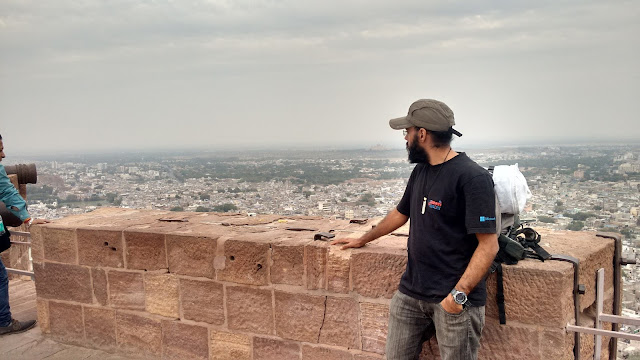 |
| On top of Mehrangarh fort |
Near the railway station I went to the sweet shop again to say thanks to Mohan Bishnoi who guided me for Khejarli. He was really happy to see me again and knowing that I had a good stay. Then he told me about the Bishnoi tiger force that is taking care of the wildlife here, with 2000 members. He told me about other places in Rajasthan that may interest me and one interesting fact that I did not knew. He was himself from Guda Bishnoi and Guda Bishnoi was the village near which Salman killed the deer, the famous black buck case. And since this was a village of Bishnois, he couldn’t escape from it as they made a good protest against the kill. I felt really proud of this community, the true and most ancient environmental crusaders of India. It was a nice closing to my experience with Bishnoism. I said good-bye to him and after an hour of wait at station I boarded my train to Ganganagar for my next stop, thinking continuously what happened in the last two days. I look forward to visit this place again :)




